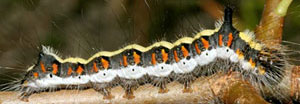 | Butterfly Conservation Saving butterflies, moths and our environment | Upper Thames Branch |  |
Gardening for Butterflies and Moths | |||||||
| Many of us try to attract butterflies by planting nectar sources, like buddleia, in our gardens. Planting flowers raises an
expectation which often leads to the question, "Why don't I see many butterflies?".
There are several reasons, but the most important is that nectar sources simply retain butterflies which would otherwise fly
straight through your garden. Nectar sources alone do not increase the numbers of butterflies. Unlike bees that really benefit from extra nectar sources (as all the stages of their life cycle feed on nectar), butterflies only feed on nectar in the adult stage. Every adult butterfly has spent weeks as a caterpillar, eating leaves. Unless the plants that caterpillars need are growing in or near your garden, you will not see the adults. Some planting suggestions for various areas of the garden are listed below; click the appropriate boxed link to view them. More information about gardening for butterflies and moths can be found on the Butterfly Conservation web site. Finally, don't forget to submit your garden records, either during or at the end of the season. |  Peacock on blackthorn flowers, which provide an excellent nectar supply early in the year. Blackthorn is the foodplant of several species of garden moth such as the Grey Dagger (below).  | ||||||
| Long Grass Areas Short Grass Areas Borders and Containers Hedges and woodland edges Large Trees | |||||||
Plants for borders and containers | |||||||
| Some plants do well in borders and containers, but struggle in grassed areas. It is worth considering the amount of sun they will get before positioning them, and how you will group the plants. A group of similar plants will be more likely to attract egg laying females than individual plants spread around the garden. | |||||||
| Many caterpillars will thrive in a semi-shaded spot but some will need to be in full sun, or full shade. Containers not only allow the growing of plants in spaces with no soil, or with a different acidity to the local soil, but also the movement of the plant during the year, including bringing them under cover for the winter. Plants with very invasive roots (e.g. nettles) can be restrained inside containers. | |||||||
| |||||||
Copyright © Butterfly Conservation Upper Thames Branch 2025
Privacy and Copyright Statement
Butterfly Conservation : Company limited by guarantee, registered in England (2206468)
Registered Office: Manor Yard, East Lulworth, Wareham, Dorset, BH20 5QP, Tel: 01929 400 209
Charity registered in England & Wales (254937) and in Scotland (SCO39268)
Privacy and Copyright Statement
Butterfly Conservation : Company limited by guarantee, registered in England (2206468)
Registered Office: Manor Yard, East Lulworth, Wareham, Dorset, BH20 5QP, Tel: 01929 400 209
Charity registered in England & Wales (254937) and in Scotland (SCO39268)
